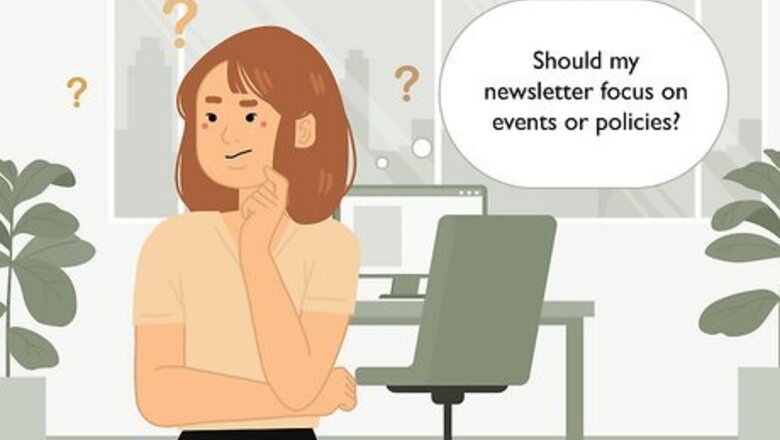
views
Planning the Newsletter
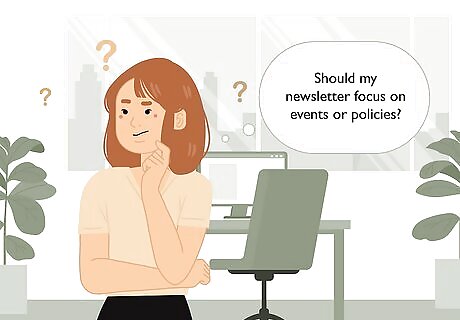
Set goals for your newsletter. Before you get too far in planning your newsletter, it can be a good idea to consider the goals you have in mind for it. Thinking about the goals that you want your newsletter to achieve can help you build a successful newsletter. Consider some of these aspects of a newsletter and decide what you want your own newsletter to achieve: Should your newsletter focus on events or policies? Are you going to create and publish the newsletter on your own? Do you plan on building a team to publish the newsletter? How big do you want your newsletter to be? How many people do you want to reach with your newsletter? What should the newsletter be called?
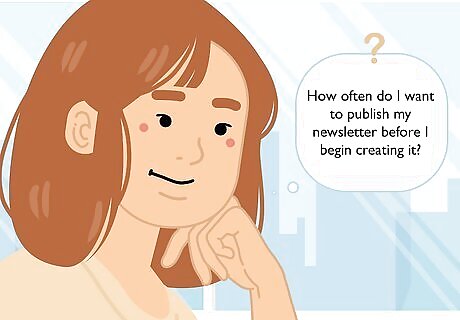
Decide how often to publish. You will need to decide how often you want to publish your newsletter before you begin creating it. Having a publication schedule can help you determine how often you'll need to work on the newsletter and when new issues are due. Decide on a publication schedule before planning the rest of your paper to help make it successful. If your school is either very large or very active, you may want to publish more often or publish larger papers, less frequently. If you are unsure of how often to publish, you may try publishing monthly to begin with. You probably won't need to publish any editions over the summer months if your school isn't active during them.

Know your audience. When planning and creating a school newsletter, it can be helpful to keep your audience in mind. The goal of your newsletter will be to inform and engage your audience. Knowing your audience will allow you to write articles and content that is tailored just for them. You'll likely want to include some sections or content for the students in the community. Your main readers are likely to be the parents and adults in the community. Your newsletter should also keep staff informed, describing current events at the school. You might also want to include content that supports your local community.
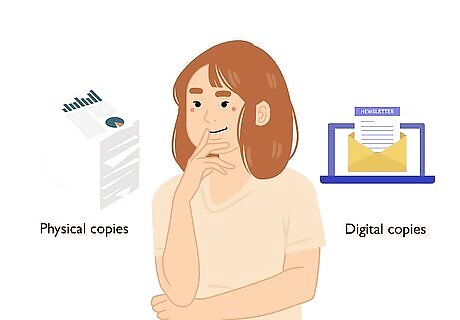
Pick a distribution method. Once you have an idea of what your newsletter will include, it's time to think of how you will deliver it to readers. Having a plan in place for distribution will help you reach as many people as possible after your newsletter has been completed and printed. It can also be helpful to think about the size of the school. How many people do you need to reach? Consider some of these distribution methods when deciding what's best for your newsletter: It's important to remember that not everyone might be able to receive digital newsletters. You will likely want to print out physical copies as well. Physical copies will either need to be delivered or placed in a public space that allows for people to easily pick up a copy. Digital copies will likely be the most cost effective option and will allow you to reach a large number of readers.
Creating the Newsletter

Get some publishing software. Today, most school newspapers are created digitally. Because of this, you will need to download and install some publishing software. There are many different options available when looking for desktop publishing software. Check out some of these examples of desktop publishing software to help get you started: Adobe InDesign, Corel Draw, and QuarkXpress are all professional publishing software. Scribus is open-source desktop publishing software. You can make a newsletter using Microsoft Word or OpenOffice Some people find Google Docs to be a good solution, as it allows many people to collaborate on-line.

Create or find a template. Templates will allow you to quickly create the first edition of your newsletter. A good template will also help you create new editions and give your newsletter a sense of cohesiveness. You can either start with a pre-made template or create one of your own. Most publishing software will include a number of templates for you to choose from. You can try searching on-line for free school newsletter templates. Templates allow you to easily add your own information or update old information. A good template will have spaces for both your articles and photos to go with them. You might want to make templates for specific months. For example, you might have a template for February that has a heart theme because of Valentine's day. For text areas, it's a good idea to have predefined spaces for your title, headings, and the main body of text.
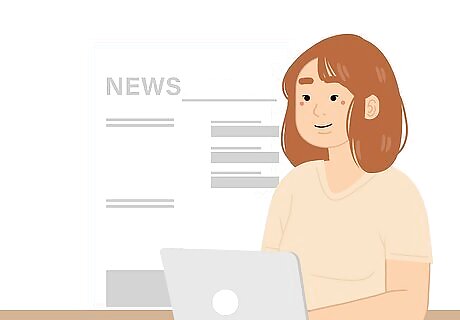
Customize your newsletter. Once you've built or found a template, you will want to customize it. Customizing a template will let you add elements that you want to continue across all editions of your school newsletter. Take a look at this list to discover some of the things you might want to add to your template: Place the school name at the top of the front page. Add in a footer with page number, date, edition, or other information you might want to include. Putting your school logo somewhere on the front page can be a good idea. Include clip-art to give your newsletter an appealing and interesting look. You might want to have dedicated pages for certain content. For example, you could put contact information for school staff on the last page of your newsletter. You'll likely want to decide the basic layout for articles and pages. A simple two column layout can be a good way to start.

Create content. After you've created and customized a newsletter template, you can begin to create content for it. The content you create should strive to meet the goals of your newsletter and be appealing to your audience. To help get you started, try reading over these examples of what a school newsletter might contain: A calendar of the year and upcoming events. Current news. Upcoming activities or programs. Birthdays. Community news. Changes in school policy.

Keep content informative. It can be a good idea to add in fun things to your newsletter, such as puzzles or games. However, the majority of your newsletter should be informative content. If a piece doesn't seem to convey any information to the reader, you may want to consider rewriting it or removing it. Always try to deliver the most information possible to your readers when publishing your school newsletter. An opinion piece on the quality of cafeteria food might be nice. However, it's probably a better idea to include a lunch schedule instead. Detailing the repair process of a restroom might be too much information. It might be better to focus on things like how long the renovation took or how much it cost. Updates on school policies should always be included. You might want to highlight student achievements in your newsletter. It can be a good idea to have small articles that introduce new staff members.
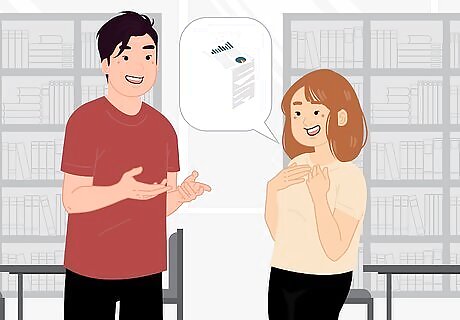
Involve others. You don't have to create an entire school newsletter yourself. Involving others can be a lot of fun for everyone. With more people working on the newsletter, both the content and the quality can be improved. Try asking students, staff or others to help create content or design the layout of your school newsletter. Asking students to write articles can be a good way to let them express a student's viewpoint and get in some writing practice. Having staff write articles can result in more detailed or informative pieces. For example, asking a math teacher to write about the new high-level math course would be a good idea. You might have students form a club around creating and publishing the newsletter. Asking for help with printing, publishing, or distributing might be necessary. You can check with local school staff, send a request for volunteers, or check with local businesses.
Delivering Your Newsletter
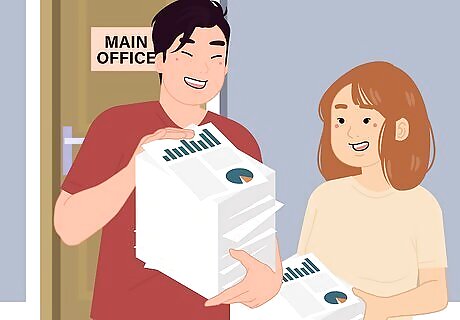
Deliver physical copies of your newsletter. If you are offering printed copies of your newsletter, you will want to make them easy to find. Placing them in an area that doesn't see much traffic will likely result in less people reading the newsletter. Sending them home in certain ways can work better than others. Always make sure that your newsletter is easy to locate or is likely to be delivered successfully. You'll likely want to create a list of people who want to subscribe to your newsletter. Try leaving it near the entrances to your school or local businesses. Bring some copies to your nearby library to put out for people to take. Leaving some copies on the front desk of the main office can be a good idea. If you have the budget, your school may mail printed copies to the community. Give the paper to students to take home. Some have found that giving the newsletter to younger children increases the chances of it getting home.

Deliver digital copies of your newsletter. Digital publication can lower costs and increase the size of your reader base. There are many methods that you can use to easily send your newsletter digitally to your readers. Try using some of these methods to send your newsletter out digitally: You can use group emails to send out your newsletter. You might post new editions on your school's homepage. Use your school's social media accounts to let people know about new editions of your paper. You could build a dedicated website or blog to post new editions of your newsletter.

Keep track of your paper. It can be a good idea to record and track some information about your newspaper. Collecting this data will tell you how many people are reading it, how many copies are actually being used, or even what information people prefer to read about. This information can help you create a better paper and will allow you to meet the needs of your readers. Keep track of how many paper copies are taken by readers. This can tell you if you need to print more or less copies in the future. Counting how many copies are taken from different locations will tell you where the best places are to distribute the paper. For digital versions, you can track how many people download the paper and from where. This can help you learn if people are finding the paper on your school's homepage or from social media. You might include reader surveys that would allow for constructive feedback.














Comments
0 comment